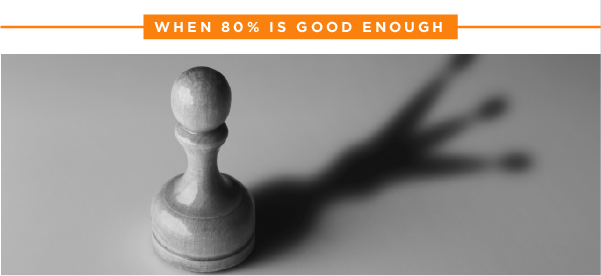More times than I care to remember, I get in my own way by trying to be perfect. I get stuck in the fixed mindset trying to attain flawless results and perform at extremely high standards in almost all aspects of life. I identify with performing perfectly, finding it difficult to be satisfied with myself unless I am succeeding beyond all expectations. It is exhausting, unsustainable, and, while a recipe for high performance, a guaranteed ticket to unhappiness.
And as usual, I am teaching what I need to learn the most. I am challenging myself and our clients to take a hard look at when overthinking, overdoing, and over-polishing their work leads to diminishing returns.
If you’re ready – if you are prone to perfectionism – I want you to ask yourself this question: When is 80 percent good enough? If your knee-jerk, visceral reaction is “never,” I am going to ask you to think again. When is 80 percent good enough?
This 80 percent number seems to be surrounding me recently. It is coming up in my weight loss goals, particularly relating to healthy eating; it’s coming up in my workouts; it’s coming up in my project work. No matter where I turn, it seems to pop up as a reminder to relax the straightjacket of perfectionism that seems to be paralyzing me at times.
So let’s talk about this 80 percent guideline for “good enough” from these three perspectives – eating, energy, and project work.
One of the areas that I have been wrestling with over the last three years is healthier eating. My primary motivation has been to facilitate a healthier lifestyle and overcome some health challenges I’ve had. I’ve worked with personal trainers, dieticians and nutritionists, as well as reading many books on the topic, and the one thing that I have not internalized, even though I’ve heard it repeatedly, is don’t eat until your full – eat until you feel 80 percent full. One of my less sensitive ways to describe what that means is “Push away from the trough.”
I have been experimenting with doing just that, pushing away from the lunch and especially the dinner table when I am feeling 80 percent full. Although I have no real way of gauging it (it’s not like the gas gauge in your car, which is a hopefully accurate reading of how full or empty your gas tank is), it is a feeling, a mindset, and a target to experiment with. Lo and behold, I feel better, seem to have more energy, and am losing weight (about 4 pounds in six weeks). Not only am I feeling better, I am sleeping better, and my blood pressure is lower and in line with where I want it.
I also feel strongly about the 80 percent rule as it relates to exercise and physical exertion. When training in any sport requiring aerobic and anaerobic conditioning, I used to bristle (at least silently) at the notion of giving 110 percent; isn’t 100 percent, full-out effort? And then I was validated by an article about Lebron James where he readily admits to taking a few plays off or working at less than 100 percent throughout the game so that he could give 100 percent when the game was on the line.
I think I now recognize the 110 percent mantra for what it is – motivation for you to try harder and to increase your potential. But often not only does it not motivate, it demotivates people when they recognize it is not sustainable. In many high-intensity interval training workouts, the idea is to go all out for a short period of time and then take a rest before giving it your all in subsequent rounds of the training.
I can already hear you high achievers, challenged by this concept and not buying into the idea at all. But please keep in mind this 80 percent idea is a guideline for sustainable high performance over time. Our inability to accept 80 percent in certain parts of our workout – or our job – is one of the reasons we work way too hard at times.
I recently did a training session with a group of “110 percenters” who were complaining about how overloaded they were and how they felt they would never catch up. At that moment I had the evidently unmitigated gall to ask, “What would your schedule look like if you were able to work toward an 80 percent solution for the tasks you have on your plate?” While they didn’t physically throw me out, it was clear I had crossed a line, to even suggest to anyone who has been trained in exactness and precision that an 80 percent solution was ever acceptable. But it is.
How many things do we over-engineer, over-design, overthink, and over-worry about? It seems we’ve always got to put something in play, test it out, make it better – we’re always shooting for that 110 percent. And while I realize there are some exceptions, what I am giving you is a guideline, a general rule that will help you with the management of your time and energy. What would 80 percent look like? Is 80 percent good enough? Or how could 80 percent be good enough in a particular part of the project you are working on?
Sometimes “good enough” is, truly, good enough.

Comments (0)